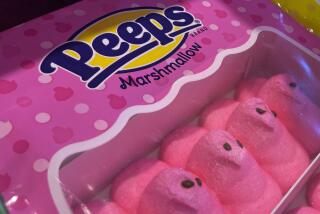New Fake Fat Is Safe, Federal Advisers Decide : Nutrition: Action moves Olestra closer to government approval. But committee members voice concerns over side effects and urge labeling.
WASHINGTON — The controversial new experimental fat substitute, Olestra, took a big step toward government approval Friday when most of the members of a federal advisory panel concluded that it was safe for human consumption.
But numerous members of the Food and Drug Administration’s food advisory committee expressed concerns about the product’s side effects, which include diarrhea-like symptoms and possible depletion of important nutrients from the body. They urged that, if Olestra is approved, foods containing it be labeled to make consumers aware of its potential problems.
Procter & Gamble Co., the developer of Olestra, has asked the agency to approve its use only in salty-type snack foods such as potato and tortilla chips, cheese puffs and crackers.
The advisory group took no formal vote, and was asked by the agency only to decide whether the substance posed “a reasonable certainty of no harm,” the standard required by law for food additives.
The agency is not bound by the advice of its advisory panels, but takes their opinions very seriously.
*
Friday’s action makes it more likely--but not certain--that the substance will be approved when it comes up for final review, expected within the next two months.
Committee members wrestled with the key question: What is harm?
“To me, it means an allergic reaction--something really bad,” said Dr. Larry Johnson, the retired chairman of the gastroenterology department of the Uniformed Services University of the Health Sciences, the military’s medical school.
“But a side effect like this is really a side effect of your willingness to eat the product,” added Johnson, a committee consultant. “Some people have a drink at night and know they will have heartburn--but still wish to have that drink.”
But committee member Dennis Hsieh, a professor of environmental toxicology at UC Davis, was among several who strongly dissented from the panel’s conclusion.
“There is no such thing as a harmless chemical,” he said. “It is the dose that determines whether a chemical is a remedy or a poison. It all depends on dose.”
Americans in this diet-conscious society are constantly seeking shortcuts to lose weight and cut dietary fat, which has been associated with heart disease and certain cancers.
Approval could make a significant change in the snacks Americans buy and eat. Some industry analysts have predicted that if Olestra achieves widespread use in the marketplace, it could become another $1-billion business for the company.
Olestra, which was first studied as a possible cholesterol-reducing drug, has been in development for 25 years, and is the first so-called “fake fat” that is heat-stable and can be used in baking and frying.
Olestra is a sucrose “polyester”--a technical term for the chemical binding process--made from sugar and vegetable oil. But the extra fatty acids in it make the substance too large to be digested or absorbed by the body--which is why it adds no fat or calories.
A typical serving of regular potato chips contains 10 grams of fat and 150 calories. The same serving of potato chips made with Olestra has zero fat and 60 calories, according to the company.
The Center for Science in the Public Interest has led the attack against Olestra, saying it depletes the body of critical carotenoids, such as beta carotene, and vitamins A, D, E and K, which are believed to protect against certain cancers, stroke, heart disease, and blindness in the elderly. The group has also said it can cause gastrointestinal effects that can be debilitating in some people, and expressed special concerns over its potential impact on children.
But Procter & Gamble insisted that the substance is safe, saying it had been researched in at least 100 animal studies and 98 human trials involving more than 16,000 people, including children.
Committee members agreed that Olestra can cause laxative-like effects, but emphasized that the evidence shows it does not cause dehydration--the loss of fluids and electrolytes--the most dangerous consequence of diarrhea.
Panel members noted that most consumers will simply stop buying it if they experience problems.
Olestra’s critics, however, said that the long-term impact of vitamin depletion potentially could be far more serious than its digestive effects. Nutrients, which are digested and used by the body when they attach to fat, adhere to Olestra and are swept out of the body before they can be absorbed.
The company plans to fortify Olestra-containing foods with extra vitamins A, D, E and K to offset the problem. Adding them will “pack” the Olestra molecule so that it will no longer have space to carry off other vitamins already in the body, the company said.
The Center for Science in the Public Interest, which is backed by the American Public Health Assn. and nutritionists from Harvard University and elsewhere, said even small servings of the product also can cause nausea, bloating and so-called “anal leakage,” where the liquid product seeps out, staining underwear.
More to Read
Sign up for Essential California
The most important California stories and recommendations in your inbox every morning.
You may occasionally receive promotional content from the Los Angeles Times.










